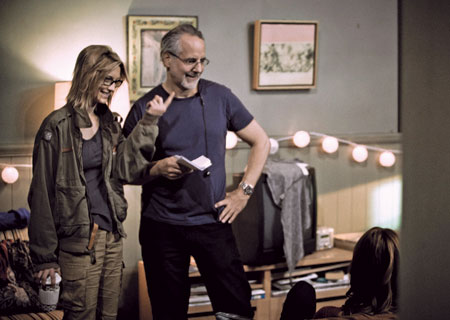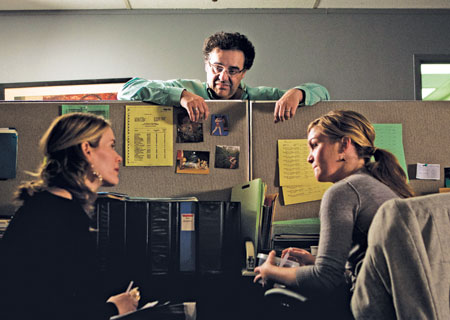By Lyndon Stambler
 NEW LOOK: Avnet directs Caitlin Gerard as Jan, the title character of WIGS’ first series. If viewers
NEW LOOK: Avnet directs Caitlin Gerard as Jan, the title character of WIGS’ first series. If viewers
like the series he hopes to extend it beyond the initial 15 episodes. (PHOTO: John Ales) Directors Jon Avnet and Rodrigo García were having lunch in Culver City three years ago when the topic turned to the Internet. Both of them agreed that there were fun videos on the web but after 15 minutes of viral fame they usually evaporated.
“It was like an appetizer that you ate but it was mostly disposable and you moved on from it,” García says. “We thought stuff could be made, even with limited budgets, with more meat on it.”
Their idea was to create an outlet on the Internet aimed at a female audience. Having both directed films with complex female characters in the past they were the right men for the job. Avnet directed, produced and co-wrote Fried Green Tomatoes (1991), and directed and produced the miniseries The Starter Wife (2007). García has long worked with ensemble female casts on such films as Mother and Child (2009) and directed Glenn Close in Albert Nobbs (2011).
They challenged themselves to create compelling webisodes for women and sought assistance from their friends and colleagues, many of them prominent directors, writers, and actors. They received seed money from YouTube and launched WIGS, a channel of scripted dramas, most of them in five- to eight-minute episodes, which debuted on May 14.
The channel began with Jan, a web series written and directed by Avnet. In the course of its 15 episodes, Jan (Caitlin Gerard) struggles to survive her first job as an assistant to a prickly photographer (Virginia Madsen), who is working on a series of photographs on celebrity couples just after they’ve had sex. García soon followed with Serena, an 11-minute one-act set in a confessional box in which Jennifer Garner explores her infatuation for her priest played by Alfred Molina.
Avnet is coy about what WIGS stands for, although promos play on the idea of “Where It Gets Sexy, Sinful, Screwed Up or Spicy.” “The notion is that women are complex and in effect wear many hats,” says Avnet.
Avnet and García, along with partner Jacob Avnet (Jon’s son, also a director), serve as executive producers on all of the series. In coming months, WIGS will post 100 episodes and documentaries made primarily by female directors, among them Lesli Linka Glatter, Rose Troche, and Ami Canaan Mann. Each series is named after the main character. Betty Thomas is directing Audrey (also known as Food Porn), a six-episode series about a food stylist whose love for food seems to be gaining over her love for men. Thomas says the experience was “director-initiated,” more like making a movie than a TV show. “There’s no one telling you what to do, how to shoot it, how to interpret it. It’s your vision,” she says.
WIGS has attracted an impressive cast of actors, including Julia Stiles, America Ferrera, Dakota Fanning and Jennifer Beals. Avnet credits the material. “This might be getting a little bit chic now but when it started it was a bunch of people who read the material and agreed to work for relatively little money. It was very pure.”
WIGS is one of a number of players that is beginning to experiment with professional web content. Internet companies such as Yahoo, AOL, Hulu, and Microsoft are all testing the waters. YouTube has invested more than $100 million to create web content, and announced at its May 2 “Brandcast,” the Internet’s version of the upfronts, that Unilever and American Express will sponsor WIGS.
“Right now it is virtually impossible to make a film for adults through the studio system,” says Avnet. “It took five years until Fried Green Tomatoes made it to the screen in 1991. And it’s only gotten harder. It took two decades for Glenn Close to bring Albert Nobbs to the screen.”
“So more platforms, outlets, more ways to tell stories and to release them is definitely a boon to directors,” adds García.
To support the effort, in 2007 the Guild developed flexible agreements to encourage members to work in new media. Russ Hollander, DGA Associate National Executive Director/Eastern Executive Director, says, “Right now, we want this to be a place that people feel free to experiment and work and develop and be creative, as long as they understand they have to be covered by an agreement.”
The provisions vary depending on the platform. “The terms are individually negotiated except that the Guild security provisions apply,” says Hollander. “Pension and health is paid on the salary negotiated between our members and whomever they’re working for, and our residuals and creative rights are attached.”
Although the pay is minimal, WIGS is committed to hiring union workers and paying into pension, health and welfare funds. “We can’t hire every member of the DGA, but we’re going to hire a lot of directors,” Avnet says. So far, WIGS has hired more than 200 people, including 19 directors.
One of those, Ami Canaan Mann, directed and wrote a three-episode series, Dakota, starring Jena Malone, about a single mom trying to become a professional poker player. “I ran it by Jon and Rodrigo and they said, ‘Get writing,’” says Mann. “Within three weeks, we were ready to shoot. It was an incredibly liberating process—immediate, fast and efficient. They allowed for a tremendous amount of creative freedom and really trusted the vision and the story.”
Nobody knows how much work the Internet will ultimately create for directors, but WIGS may provide a model that could eventually become self-sustaining. As Madsen said in a WIGS promo, “This is where entertainment is going, so get on board now or you might miss the train.”
Avnet estimates the costs to make a webisode is one-twentieth of what it would cost to make a network pilot. WIGS will shoot mainly in L.A., using Sony F-3 cameras, and employ a mix of experienced and less experienced cast and crew. The challenge is shooting high quality material with limited budgets. Avnet has projected many episodes on 18-foot screens, and believes the look of the videos “are highly competitive with network and cable.”
 FAST TRACK: Rodrigo García, directing Sarah Paulson (left) and Julia Stiles (right) in Blue, says “more outlets,
FAST TRACK: Rodrigo García, directing Sarah Paulson (left) and Julia Stiles (right) in Blue, says “more outlets,
more platforms and more ways to tell stories is a boon to directors.” (PHOTO: John Ales) Shooting on a shoestring often requires creative solutions, which is not necessarily a bad thing. For instance, Avnet, who executive produced Black Swan, was filming a ballet in a speed-dating restaurant, when he realized the soundstage didn’t have a ceiling. They couldn’t afford to use computer graphics, so they figured out how to shoot it from low angles without revealing that the set had no roof. “We’re doing this modest web series and I’m shooting with stuntmen, wires, and ballet dancers,” says Avnet. “It’s always the same. No matter what the size of the canvas, it always gets as large as possible, until you finally say, ‘OK.’”
Directors generally shoot one episode in a day. Mann, who had shot about 10 pages a day when she directed an episode of Friday Night Lights, was prepared to do the same for WIGS. “In a sense you’re writing the script to accommodate the 12-hour day that you have.”
“It’s like doing fast TV,” adds Thomas. “It has to look good and usually it’s edgier because everyone has freedom.”
Indeed, freedom is the main draw for directors. “We’ve not bound anybody’s hands with respect to how to approach the material,” explains García. “As long as we agree generally on the script and we don’t see any big mistakes in the casting department, Jon and I are basically letting the directors run with it.”
Unlike broadcast and cable TV, webisodes can be as short or long as the director wants, making them well suited for fast viewing on tablets and mobile devices. “I love how short they are,” says Mann. “You can be waiting for your bus and watch an episode on your iPhone. Hopefully, when people hook into that potential, it will take off.”
Avnet compares this phase of Internet programming to cable’s beginnings. If audiences like Jan, his hope is that will lead to more episodes. Mann adds that the risk is relatively small. “We’ll be able to tell with tremendous accuracy whether the show is popular or not simply by virtue of assessing how many hits it got. Based on that, we will know whether this particular story line should continue and in what format. It’s a great meritocracy.”
As Avnet notes, the viewers are the critics providing instant, and sometimes brutal, feedback. “In terms of directors’ hopes and dreams, you get your material up there and it gets seen. In terms of directors’ nightmares, you get your material up there and it gets seen.”
Moreover, the Internet potentially gives directors time to find an audience. “This is a way of telling stories where you’re not living or dying by reviews on a Friday and a box-office report on a Sunday, and then with a mediocre theatrical run you’re out of theaters in three weeks,” says García.
For Avnet and García, WIGS is primarily a creative, not a business venture. “This was not something that a wise man should try,” laughs Avnet. “It has to be someone who loves making movies in any form to try it.”
A month before WIGS launched, Avnet and García were exhausted as they finished work on Jan and Serena. Nevertheless, they found inspiration at the WIGS offices in Culver City, which houses the postproduction facilities. At one point, six directors were cutting simultaneously. And at their production facility, a 31,000 square foot soundstage two miles away, there were four or five directors shooting or prepping. “We had Ami Mann cutting, Marta Kauffman prepping, Mitch Albom directing, and Rose Troche directing something Scott Turow had written,” Avnet says proudly.
They hope such talent will help establish WIGS, but they know it will take time. “The day we pay out profits on this to any director, writer, or actor, will be the day we have a sustainable business model,” Avnet says. “If that happens, we’ll go back to that restaurant for champagne.”